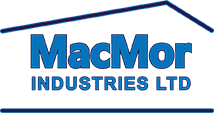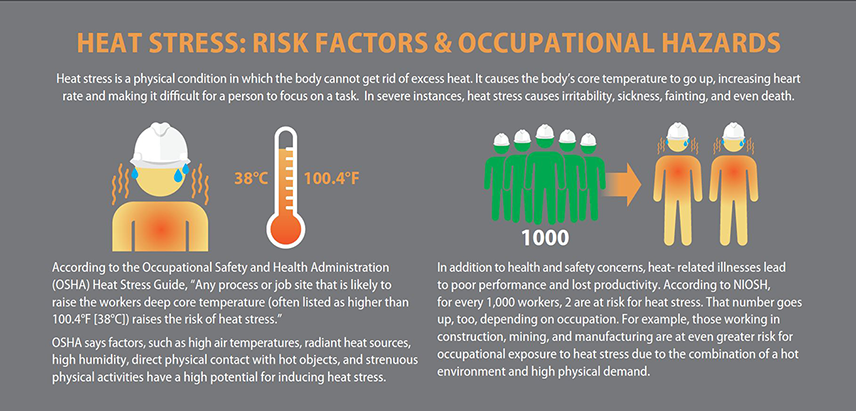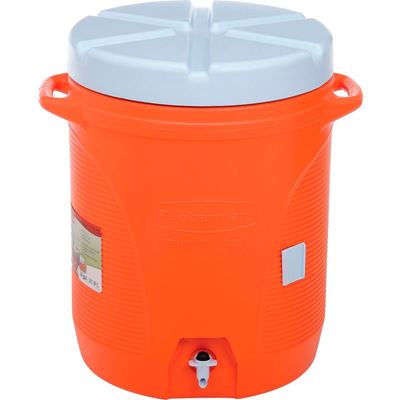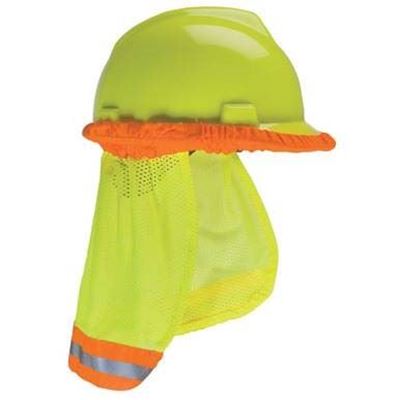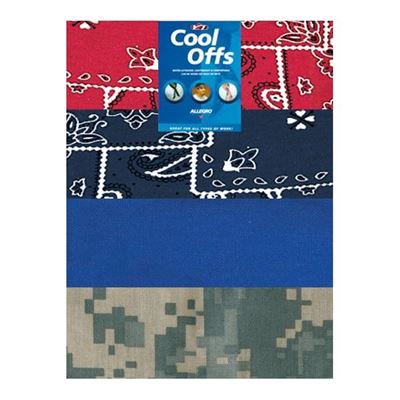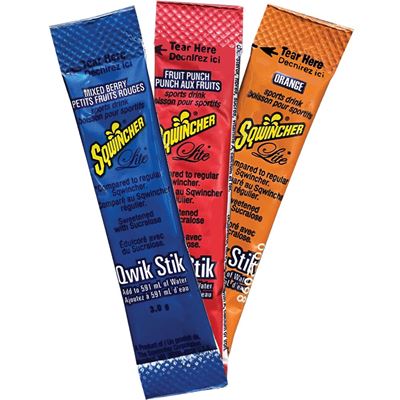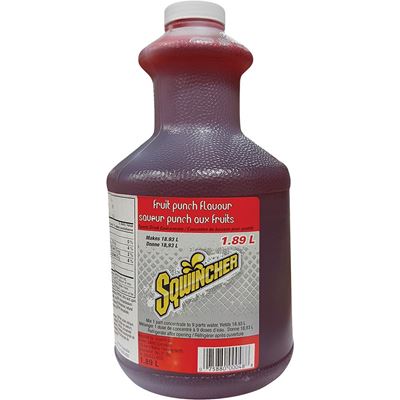This page contains: Causes of Heat Stress, Effects of Heat Stress, Tips for Preventing Heat Stress, and Products That Help Prevent Heat Stress
Cool-off Essentials - How to Combat Heat Stress
Welcome back to Feature Friday! This week we’re taking a deep dive into the topic of Heat Stress. With summer now in full swing, increased exposure to heat and humidity poses an elevated risk to those working outdoors.
Now, before discussing the contributing factors and effects of Heat Stress, it's important to explain how it occurs. Occupational Heat Stress or Thermal Stress is defined as any process or work environment that can raise a worker’s internal body temperature above 38°C (100.4°F). Heat stress is primarily caused by the inability to manage the impact of heat and humidity on the body, resulting in symptoms that range from very mild (dizziness, headaches) to fatal (heat strokes, loss of consciousness, seizures).
What Causes Heat Stress?
One of the most prominent causes of heat stress is lack of hydration. As your body's temperature begins to rise from exposure to the sun and physical exertion, you begin to lose fluids and salt through sweat - the body's natural cool-down protocol. As your fluid levels diminish, your body becomes less capable of regulating its internal temperature which typically leads to internal systems failing and shutting down.
Another major factor that can bring about heat stress is improper acclimation to warm temperatures. This is often observed in new employees, employees returning from extended vacation or absence, and employees experiencing a new work environment (going form indoor/shaded conditions to outdoor/sunny job sites).
Lastly, one of the more controllable contributors to heat stress is the type of clothing worn on the jobsite. Clothing has a noticeable impact on your body's ability to regulate its temperature as it is the only barrier between your body and the environment. Heavy materials and darker colours commonly found in "durable" workwear or FR apparel are not always the best option for working outside on a hot day.
A better option is something lightweight like a loose fitting cotton or polyester shirt, and preferably in a light colour. If you require Hi-Viz apparel, it is best to go with something lightweight and breathable like this Lime Green Polyester Traffic T-Shirt
What are the Effects of Heat Stress?
The effects of heat stress can vary greatly, ranging from mild symptoms like dehydration to heat-related illnesses such as heat exhaustion or heat strokes.
Mild Symptoms
For the most part, mild symptoms of heat stress are most common experienced. These effects are often overlooked because they are easier to ignore and "work through". However, mild symptoms such as altered mental capacity, dizziness or nausea can result in serious workplace accidents when combined with certain tasks.
Take for example someone working on a ladder; a flash of dizziness on a hot day could result in a fall that could cause injury, leading to extended lost time. Better yet, suppose you are working at 100 feet. A mild symptom of heat stress such as confusion could result in an improperly tethered tool falling to the ground and potentially causing a fatal impact.
For more information on proper tool tethering see This Blog Post about the potential dangers of improperly tethering your tools. These are just some of the many results that can be caused by mild symptoms of heat stress. It is important to not brush these off because one slip of judgment (or your feet) can have deadly consequences.
Serious Symptoms
Some of the more serious outcomes of Heat Stress are:
- Heat Stroke - Requires immediate medical attention
- Heat Exhaustion - Stop what you're doing, cool off, drink lots of fluid and do not return to your task
- Rhabdomyolysis - Breakdown of the skeletal muscle fibers which requires immediate medical attention
- Heat Syncope - Sudden Fainting or Diziness. Do not return to work, cool off and drink lots of fluids
- Heat Rash - Can lead to serious infections if not handled properly
These conditions put workers at risk of missing significant periods of time due to recovery, can have long-term effects, and can even result in death. For more information on First Aid Practices and information on identifying serious symptoms of Heat Stress, check out these CDC Guidelines

Tips for Preventing Heat Stress
- Management Controls
- Provide breathable High Visibility Safety Apparel
- Increase the number of workers per task
- Provide an adequate source of cold water
- Train workers and supervisors with proper heat stress training (identification and first-aid)
- Worker
- Being able to recognize signs of heat stress
- Proper care and use of heat-protective clothing
- Reporting symptoms
- Self-evaluation and taking breaks when needed
- Wear clothing made of light breathable fabrics and avoid dark colours
- Follow a work/rest cycle
- Acclimation
- New workers should be exposed to no more than 20% direct heat/sunlight in their first and increasing by 20% in each subsequent day
- For workers who are familiar with the job, exposure should be limited to 50% exposure on day 1, 60% on day 2, 80% on day 3, and 100% on day 4.
- For more information on Acclimation, check out NIOSH recommendations
- Hydration
- For moderate work activities, drink 1 cup of water every 15-20 minutes
- Keep water colder than 15°C
- During prolonged sweating lasting several hours, drink sports drinks containing balanced electrolytes.
- Avoid energy/sports drinks with high caffeine or sugar contents

Products That Help Prevent Heat Stress
At MacMor Industries, we carry a few key items that will play a significant role in keeping you cool during the summer months.
Cool-offs
Usable as a neck wrap or a headband, Cool Offs utilize cooling crystals that absorb and lock in water reducing the “slimy effect”. They are quilted into four sections to provide additional comfort and cooling effects.Hard Hat SunShades
MSA’s Hard Hat SunShade provides a breathable neck cover that is made of Hi-Viz mesh fabric. It clips to your hard hat to keep it from falling or rotating off of the Hard Hat.
Water Cooler
Rubbermaid® Water Coolers are essential for a hot job site. The drip-resistant spigot, screw-tight lid, durable construction makes it perfect for storing large quantities of water on-site. Rubbermaid® Water Coolers are available in 3, 5, and 10 Gallon sizes. Lastly, the extra-thick insulated lining keeps water cold all day, ensuring adequate water is available on-site
Hydration Packs
Sqwincher® Qwik Stiks Drink Crystals are perfect for on-the-go hydration. It provides a simple solution to electrolyte replenishment. Sqwincher® is available in 3 amazing flavours - Orange, Mixed Berry and Fruit Punch.
Contact Us
If you or your organization need any information regarding cool-off products, or any PPE for that matter, please do not hesitate to contact us. One of our Safety Specialists would be more than happy to assist you
Like the Blog and Video? Please consider sharing it with your friends and your team.